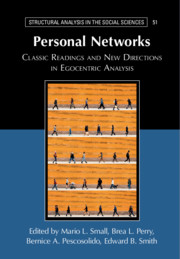Book contents
- Personal Networks
- Structural Analysis in the Social Sciences
- Personal Networks
- Copyright page
- Contents
- Figures
- Tables
- Contributors
- I Background
- II Early Foundations
- III Later Foundations
- 8 From Claude S. Fischer, To Dwell among Friends
- From the Northern California Community Study, 1977–1978, to the University of California, Berkeley, Social Networks Project, 2015–2020
- 9 From Mark S. Granovetter, “The Strength of Weak Ties”
- Strength of Weak Ties in the Labor Market: An Assessment of the State of Research
- 10 From Barry Wellman and Scot Wortley, “Different Strokes from Different Folks”
- A Network Pilgrim’s Progress: Twenty-Six Realizations in Fifty-Five Years
- 11 From James S. Coleman, “Social Capital in the Creation of Human Capital”
- Three Decades of Research into Social Capital: Achievements, Blind Spots, and Future Directions
- 12 From Bernice A. Pescosolido, “Beyond Rational Choice”
- Confronting How People Cope with Crisis: From the Social Organization Strategy Framework to the Network Episode Model to the Network Embedded Symbiome
- 13 From Scott L. Feld, “The Focused Organization of Social Ties”
- Reflections on “The Focused Organization of Social Ties” and its Implications for Bonding and Bridging
- 14 From Ronald S. Burt, Structural Holes
- Structural Holes Capstone, Cautions, and Enthusiasms
- 15 From Edward O. Laumann, Peter V. Marsden, and David Prensky, “The Boundary Specification Problem in Network Analysis”
- On the Boundary Specification Problem in Network Analysis: An Update and Extension to Personal Social Networks
- 16 From Miller McPherson, Lynn Smith-Lovin, and James M. Cook, “Birds of a Feather”
- The Enormous Flock of Homophily Researchers: Assessing and Promoting a Research Agenda
- 17 From Robert Huckfeldt and John Sprague, “Networks in Context”
- Individuals, Groups, and Networks: Implications for the Study and Practice of Democratic Politics
- 18 From Nan Lin, “Building a Network Theory of Social Capital”
- Social Capital: An Update
- 19 On the General Social Survey
- IV New Perspectives
- Index
- Recent Books in the Series
- References
8 - From Claude S. Fischer, To Dwell among Friends
from III - Later Foundations
Published online by Cambridge University Press: 01 October 2021
- Personal Networks
- Structural Analysis in the Social Sciences
- Personal Networks
- Copyright page
- Contents
- Figures
- Tables
- Contributors
- I Background
- II Early Foundations
- III Later Foundations
- 8 From Claude S. Fischer, To Dwell among Friends
- From the Northern California Community Study, 1977–1978, to the University of California, Berkeley, Social Networks Project, 2015–2020
- 9 From Mark S. Granovetter, “The Strength of Weak Ties”
- Strength of Weak Ties in the Labor Market: An Assessment of the State of Research
- 10 From Barry Wellman and Scot Wortley, “Different Strokes from Different Folks”
- A Network Pilgrim’s Progress: Twenty-Six Realizations in Fifty-Five Years
- 11 From James S. Coleman, “Social Capital in the Creation of Human Capital”
- Three Decades of Research into Social Capital: Achievements, Blind Spots, and Future Directions
- 12 From Bernice A. Pescosolido, “Beyond Rational Choice”
- Confronting How People Cope with Crisis: From the Social Organization Strategy Framework to the Network Episode Model to the Network Embedded Symbiome
- 13 From Scott L. Feld, “The Focused Organization of Social Ties”
- Reflections on “The Focused Organization of Social Ties” and its Implications for Bonding and Bridging
- 14 From Ronald S. Burt, Structural Holes
- Structural Holes Capstone, Cautions, and Enthusiasms
- 15 From Edward O. Laumann, Peter V. Marsden, and David Prensky, “The Boundary Specification Problem in Network Analysis”
- On the Boundary Specification Problem in Network Analysis: An Update and Extension to Personal Social Networks
- 16 From Miller McPherson, Lynn Smith-Lovin, and James M. Cook, “Birds of a Feather”
- The Enormous Flock of Homophily Researchers: Assessing and Promoting a Research Agenda
- 17 From Robert Huckfeldt and John Sprague, “Networks in Context”
- Individuals, Groups, and Networks: Implications for the Study and Practice of Democratic Politics
- 18 From Nan Lin, “Building a Network Theory of Social Capital”
- Social Capital: An Update
- 19 On the General Social Survey
- IV New Perspectives
- Index
- Recent Books in the Series
- References
Summary
Taking up the invitation to reflect on the mid-1970s project that resulted in To Dwell Among Friends (1982), I review its development, my network survey of the 2010s, and lessons learned. This chapter discusses the decision to use egocentric network analysis as a tool to understand urban modernity in the first project and to study the effect of social ties on health in the second. The accounts spur discussions of several conceptual issues, such as the importance of considering burdensome ties, the notion of “social capital,” and the criteria for deciding a tie even exists, as well as several methodological issues, including the GSS “important matters” question, the reasons for using multiple and diverse name-eliciting questions, and the respondent burden this method creates.
- Type
- Chapter
- Information
- Personal NetworksClassic Readings and New Directions in Egocentric Analysis, pp. 213 - 226Publisher: Cambridge University PressPrint publication year: 2021
References
- 2
- Cited by



